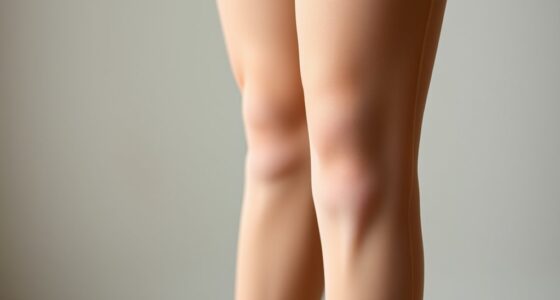To keep your dance tights in top shape, choose durable fabrics with good stretch recovery, handle tears promptly, and wash gently in cold water without harsh chemicals. Air dry flats or hang them in a shaded, well-ventilated area to prevent fading and damage. Store them carefully to avoid snags and always replace them when they show signs of wear. If you want to learn how to maximize their lifespan and maintain their performance, continue exploring these essential tips.
Key Takeaways
- Always wash dance tights gently in cold water with mild detergent to preserve elasticity and color.
- Air dry tights flat or hung in a shaded, well-ventilated area, avoiding direct sunlight and heat sources.
- Handle tears immediately with care; use small repairs or replace if damage is extensive.
- Store tights properly in a dedicated, breathable space to prevent stretching and fabric deterioration.
- Choose high-quality, durable tights with reinforced toes and fade-resistant dyes for longer wear and vibrant color.
Choosing the Right Dance Tights for Longevity
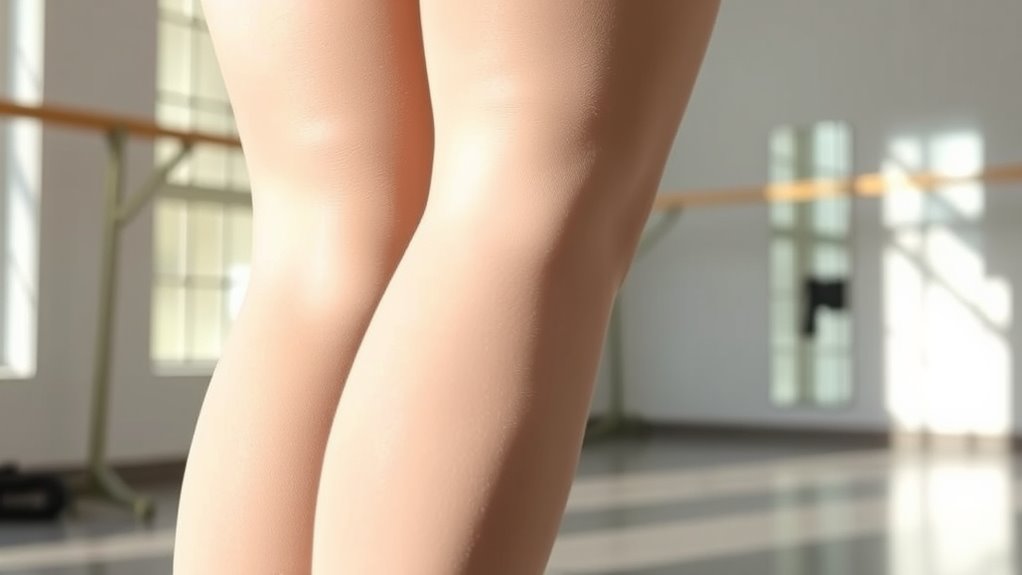
Choosing the right dance tights is essential if you want them to last through numerous rehearsals and performances. Focus on fabric durability to guarantee they withstand constant stretching and movement without tearing or losing shape. Look for tights made from high-quality materials like nylon or spandex blends, which offer strength and flexibility. Equally important is color preservation—select tights with fade-resistant dyes that keep their vibrant hue wash after wash. Avoid cheaper options that may thin out, pill, or fade quickly, forcing you to replace them often. Investing in durable, color-preserving tights saves you money and keeps your look consistent on stage. By choosing wisely, you ensure your tights stay supportive, vibrant, and ready for every dance session. The importance of material strength cannot be overstated in maintaining the longevity of dance tights. Additionally, selecting tights with stretch recovery properties helps them maintain their fit and prevent sagging after repeated wear. Furthermore, opting for tights with color fastness ensures the vibrant appearance remains intact over numerous washes. Incorporating tights with reinforced toes can also prolong their lifespan, especially for performances involving a lot of movement.
Proper Washing Techniques for Delicate Fabrics
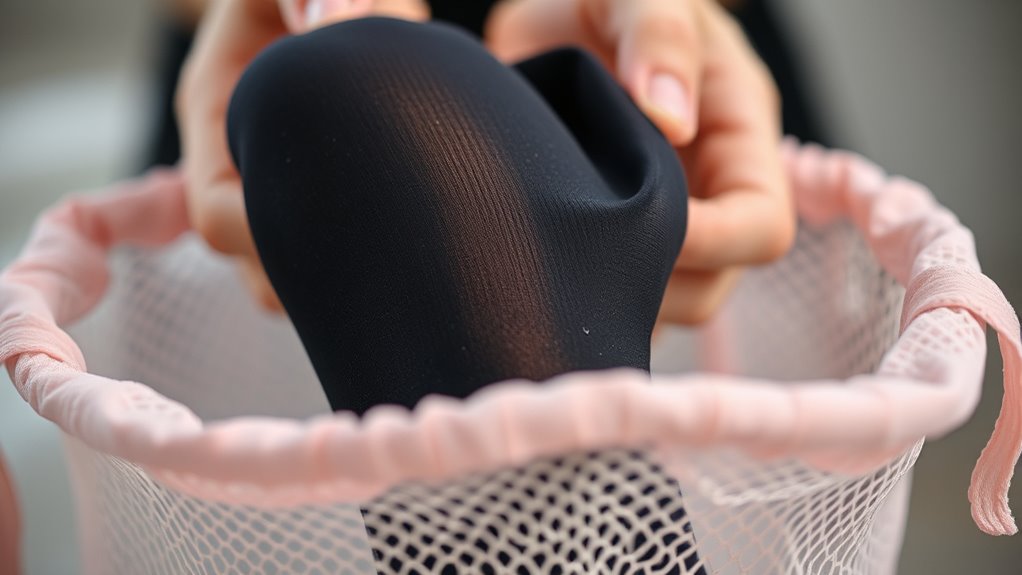
When washing your delicate dance tights, use gentle methods like hand washing with mild detergent to prevent damage. After cleaning, avoid wringing them out and instead lay them flat or hang them to dry naturally. Following these proper drying practices helps maintain their elasticity and prolongs their lifespan. Additionally, choosing appropriate laundry detergents that are free from harsh chemicals can further protect the fabric fibers.
Gentle Washing Methods
To keep dance tights in great condition, you need to wash them gently using proper techniques suited for delicate fabrics. Use cold water and a mild detergent, avoiding fabric softeners that can weaken fibers. When dealing with stains, gently pre-treat with a stain remover or soak briefly to prevent damage.
Here’s a quick guide:
| Do | Don’t |
|---|---|
| Use gentle motions | Rub fabric vigorously |
| Pre-treat stains | Use harsh chemicals |
| Air dry or lay flat | Wring out or tumble dry |
This approach preserves elasticity and prevents pilling. Remember, delicate fabrics require special care, so handle your tights with care during every wash.
Proper Drying Practices
After gently washing your dance tights, proper drying is key to maintaining their shape and elasticity. Never wring or twist them, as this can damage delicate fibers. Instead, lay your tights flat on a clean towel to air dry, which helps preserve their form. Avoid using fabric softeners, as they can degrade the fabric’s elasticity over time. Also, steer clear of harsh laundry detergents; opt for gentle, mild options designed for delicate fabrics. Never dry tights in direct sunlight or with high heat, as this can cause fading and weaken the material. Instead, let them air dry in a shaded, well-ventilated area. Proper drying practices can also help prevent fabric degradation, ensuring your dance tights stay comfortable, stretchy, and in excellent condition for longer. Additionally, understanding sound healing science can inspire you to incorporate calming vibrations into your relaxation routines, much like caring for your dancewear.
How to Dry Your Dance Tights Safely
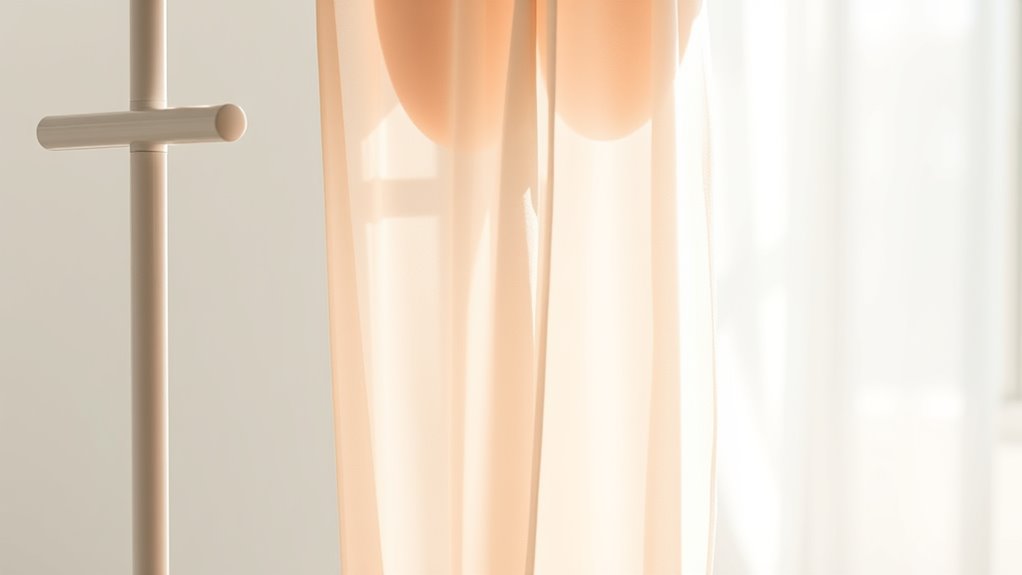
After washing your dance tights, make sure to air dry them completely before storing. Keep them away from direct heat sources like radiators or sunlight, which can damage the fabric. This way, your tights stay in great shape and last longer. To ensure the best color fidelity and overall appearance, avoid exposing them to excessive light exposure during drying. Additionally, be aware that data privacy concerns are increasingly relevant when using electronic devices to dry or care for your tights, so always consider safe handling practices. Proper handling also includes being mindful of skincare benefits, which can be supported by gentle cleaning and maintenance routines. Moreover, choosing appropriate drying methods can help preserve the elasticity and integrity of your dance tights.
Air Dry Thoroughly
Air drying your dance tights is essential to maintaining their shape and elasticity. To do this properly, lay them flat or hang them in a well-ventilated area away from direct sunlight. This prevents fabric damage and color fading. Avoid using fabric softeners or bleach alternatives, as these can weaken the fibers and reduce lifespan. Instead, opt for gentle air drying to preserve elasticity. To emphasize, consider this table:
| Tip | Why it matters | Effect on tights |
|---|---|---|
| Hang or lay flat | Prevents stretching or misshaping | Keeps fit and form intact |
| Avoid direct sunlight | Prevents color fading | Maintains vibrant color |
| Air dry in well-ventilated area | Speed up drying process | Reduces odor and mold risk |
| No fabric softeners | Preserves elasticity | Maintains stretchability |
| Skip bleach alternatives | Prevents fiber damage | Extends lifespan |
Additionally, ensuring proper ventilation during drying helps prevent mold and bacteria buildup. Proper airflow is crucial to avoid mold growth and maintain a fresh, clean condition for your tights. Using natural airflow can also help preserve fabric quality over time. Incorporating adequate air circulation can further enhance the drying process and prevent any unwanted odors.
Avoid Heat Exposure
Have you ever wondered why applying heat to your dance tights can be harmful? Excessive heat causes heat damage, weakening the delicate fibers and reducing their elasticity. To prevent this, always control the temperature when drying your tights. Avoid using dryers, radiators, or direct sunlight, as these expose your tights to high heat that can ruin their fit and durability. Instead, gently squeeze out excess water and let them air dry in a cool, shaded area. Proper temperature control guarantees your tights dry safely without compromising their quality. Remember, patience is key—rushing the drying process with heat can lead to irreversible damage, so take your time and avoid heat exposure for longer-lasting, better-performing dance tights. Additionally, understanding the importance of fiber preservation can help extend the lifespan of your tights and maintain their optimal stretch and fit. Incorporating gentle drying techniques is essential for safeguarding the fabric’s integrity and ensuring your tights stay in top condition. Using proper drying methods can further prevent unnecessary wear and tear, ensuring your tights remain supple and durable over time.
Storage Tips to Prevent Damage and Snags
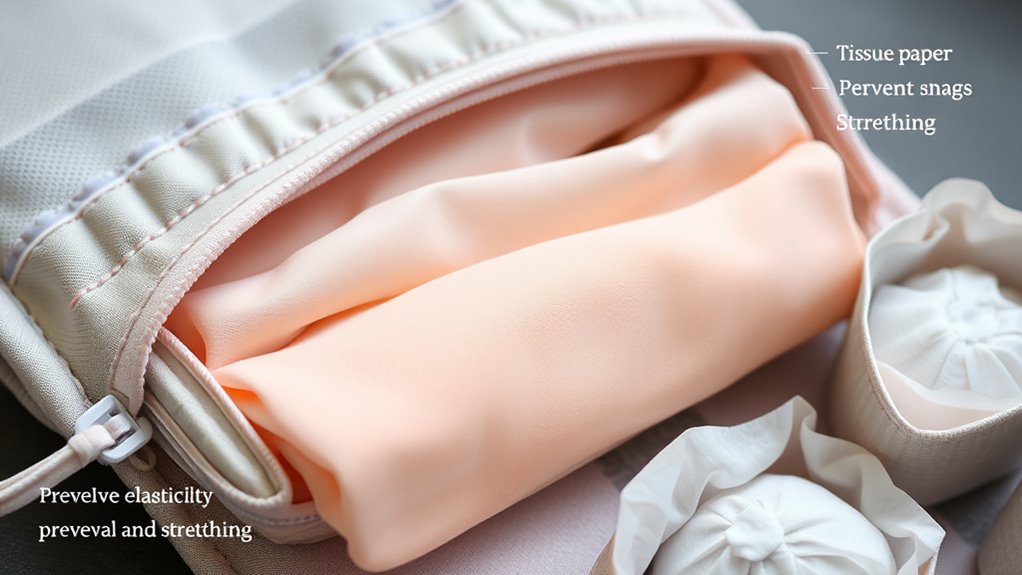
Proper storage is essential to keep dance tights in top condition and prevent damage or snags. To achieve this, avoid overcrowding your drawer, which can cause friction and snags. Fold tights gently rather than rolling them tightly, reducing the risk of stretching or tears. Keep them separate from items treated with fabric softeners, as residual chemicals can weaken fibers over time. Also, consider laundering frequency; washing tights too often increases wear, so store clean tights properly to extend their lifespan.
To further protect your tights, follow these tips:
- Store in a dedicated drawer or compartment to minimize friction.
- Use tissue paper or mesh pouches for added protection.
- Keep away from direct sunlight, which can degrade fabric over time.
Handling Runs and Tears Effectively
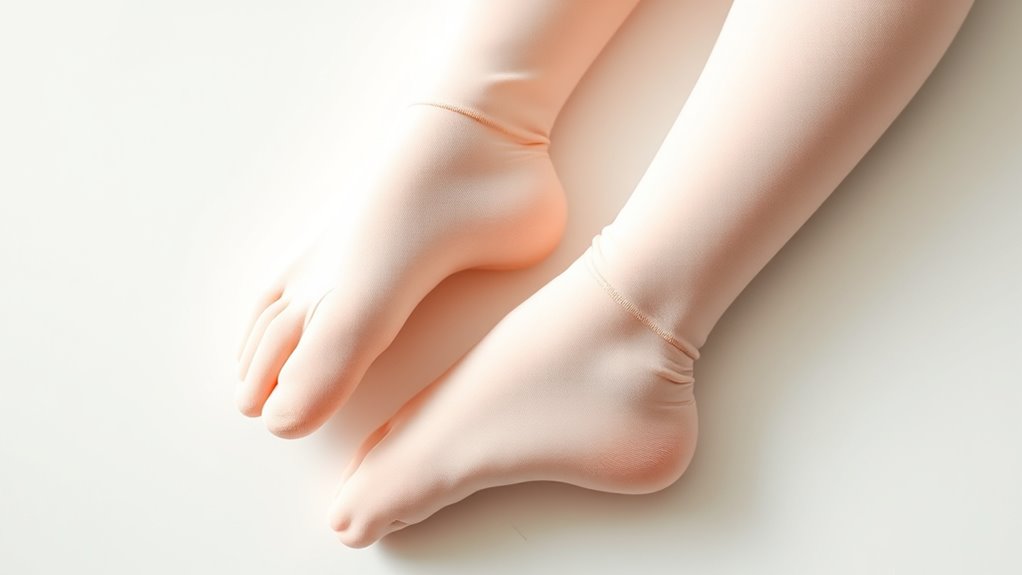
When you notice a run or tear in your dance tights, acting quickly can prevent further damage. Gently handle the area to avoid worsening the tear, and avoid pulling or stretching the fabric. To prevent fabric pilling from worsening the tear, use a small pair of scissors to carefully trim loose threads near the damage. If there’s a risk of color bleeding, wash the tights separately in cold water before attempting any repair. For small tears, you can try using clear nail polish or fabric adhesive to seal the edges and prevent the tear from expanding. Be cautious with repairs—if the damage is extensive, it’s better to replace the tights to ensure safety and comfort during your performance. Acting promptly helps extend the life of your dance tights.
Tips for Preventing Fading and Color Loss
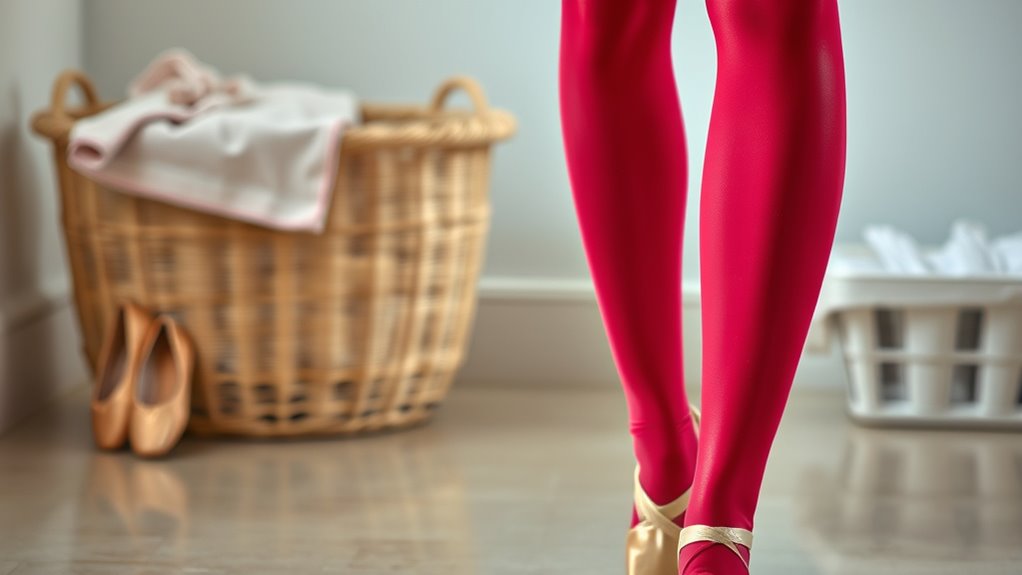
To keep your dance tights looking vibrant, it is vital to take steps that minimize fading and color loss. Start by choosing tights made with high-quality fabric dyeing processes, ensuring better colorfastness testing. Always wash tights inside out on a gentle cycle with cold water to preserve their hue. Avoid harsh detergents and bleach, which can strip color and weaken fibers. Additionally, air dry your tights instead of using a dryer, as heat accelerates fading. To further protect your tights’ color, consider purchasing from brands that prioritize fabric dyeing techniques designed for durability. Regularly performing colorfastness testing at home can also help identify early signs of fading, allowing you to take proactive steps to extend their vibrant appearance.
When to Replace Your Dance Tights
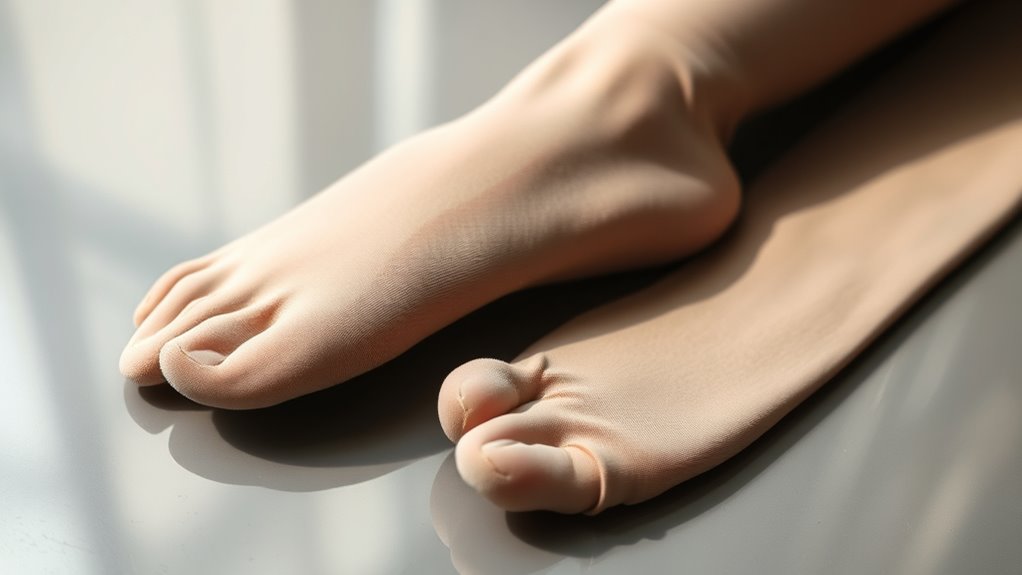
Knowing when to replace your dance tights is essential to maintaining comfort and performance. Over time, fabric blending can weaken, leading to tears or runs, especially after frequent use or washing. Additionally, dye stability diminishes with wear, causing colors to fade or streak, which can affect your confidence on stage. If your tights develop persistent snags, thinning spots, or noticeable fading despite proper care, it’s time to substitute them. Rips or holes compromise support and coverage, and worn-out fabric reduces flexibility. Keep an eye on the overall condition—if the tights no longer fit snugly or show signs of fabric deterioration, replacing them ensures you stay comfortable and perform at your best. Regularly updating your tights helps maintain the ideal fabric blending and dye stability for flawless dance sessions.
Additional Accessories to Protect Your Tights
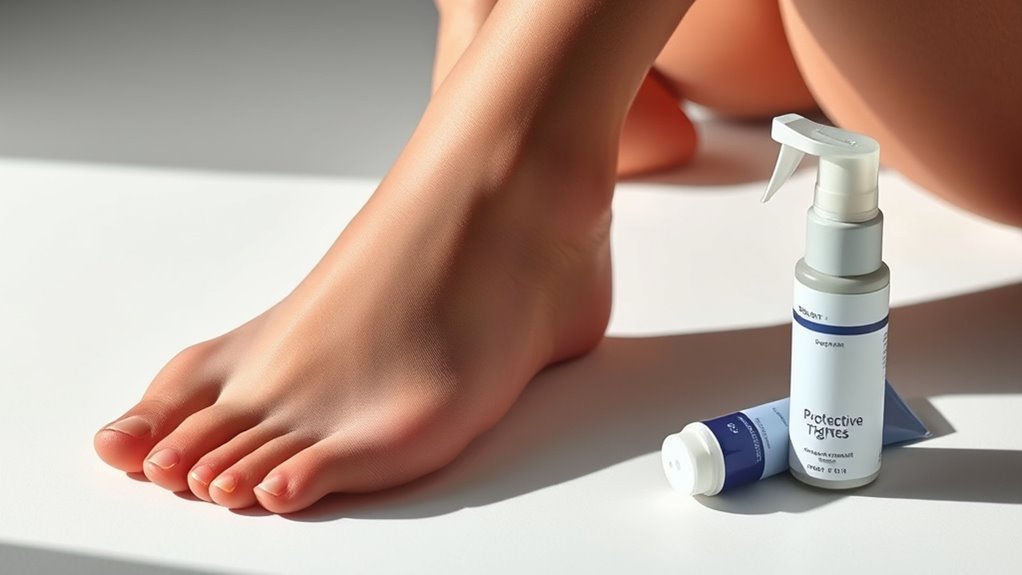
Protecting your dance tights from damage starts with using the right accessories. Incorporating dance tights accessories and protective gear can extend their lifespan and keep them looking pristine. Consider using toe pads or heel protectors to prevent runs and snags in high-friction areas. A seamless undergarment or dance belt can provide extra support and reduce friction during movement. Additionally, wearing a dance wrap or cover-up protects your tights from snags and dirt when not in use. These accessories act as a barrier, minimizing wear and tear. Investing in quality protective gear ensures your tights stay in excellent condition, so you can focus on your performance without worrying about unnecessary damage. Proper accessories are a simple yet effective way to safeguard your dance wardrobe.
Frequently Asked Questions
How Do I Choose the Best Tights for Different Dance Styles?
When choosing the best tights for different dance styles, consider fabric durability and color matching. For vigorous styles like jazz or hip-hop, opt for tights made from durable, stretchy materials that hold up to movement. If you’re performing ballet, select tights that match your skin tone for a seamless look. Always check the fabric quality to guarantee longevity, and pick colors that complement your costume or dance environment.
Can I Reuse Dance Tights After Washing?
Think of your dance tights as delicate flowers needing gentle care. Yes, you can reuse them after proper washing techniques, but only if you treat them with love. Hand wash in cool water, avoid harsh detergents, and air dry to preserve their elasticity. Following these steps extends tights longevity and keeps them looking fresh on stage. With tender care, your tights can dance through many performances, just like a star that keeps shining bright.
What Are Eco-Friendly Options for Dance Tights?
When choosing eco-friendly dance tights, you should look for options made from sustainable fabrics like organic cotton, bamboo, or recycled materials. These choices reduce environmental impact and often come in biodegradable packaging, which minimizes waste. By selecting tights with these features, you actively support sustainability efforts while enjoying comfortable, high-quality dancewear. Always check labels for eco-friendly certifications to guarantee you’re making the most environmentally conscious decision.
How Do I Prevent Tights From Slipping During Performances?
Your tights slipping during performances is like trying to hold water in your hands. To prevent this, try tightening techniques like pulling the tights snugly but comfortably, or use grip-enhancing accessories like gel pads or dance belt grips. Applying a light dusting of baby powder or anti-slip spray can also help. These simple tricks keep your tights in place so you can dance confidently without worry.
Are There Specific Tights Recommended for Sensitive Skin?
If you have sensitive skin, look for tights made from sensitive skin fabrics like cotton or bamboo, which are gentle and breathable. Hypoallergenic tights are also a great choice, as they’re designed to reduce allergies and irritation. When shopping, check labels for these features. You’ll find options that keep you comfortable and protected during performances, ensuring your skin stays happy even after long wear.
Conclusion
Taking good care of your dance tights can extend their life considerably—did you know most tights last only about 10 wears before needing replacement? By choosing the right pair, washing gently, and storing properly, you prevent snags, tears, and fading. Remember, a well-maintained pair boosts your confidence and performance. Keep these tips in mind, and your favorite dance tights will stay vibrant, comfortable, and ready for every stage!


